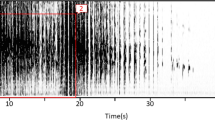Abstract
Nestling birds produce a multicomponent begging display that has visual (e.g. posturing) and vocal (e.g. call rate) elements. Most work on the function of the display has focused on each component separately. However, understanding the evolution of complex displays such as begging requires knowledge of how the components function collectively. The purpose of our study was to determine how postural intensity and calling rate together influence parental feeding decisions in tree swallows, Tachycineta bicolor. We compared how begging components responded to a manipulation in which pairs of nestlings were either free to approach the parent when it arrived to feed (unconfined treatment) or confined to the back of their nestbox by a Plexiglass partition (confined treatment). We found no significant differences in postural intensity between treatments, but calling rate was significantly higher in the confined treatment. In both treatments, postural intensity, but not calling rate, correlated with hunger. Both components positively and independently correlated with the likelihood of a nestling being fed, although the correlation with postural intensity was stronger. Previous work suggested that both posture and call rate advertised hunger in nestling tree swallows. Here, call rate was not associated with hunger, but rather was affected by nestling position. These results suggest that calling may serve an additional role in helping nestlings in disadvantaged positions attract parental attention. The results also suggest that calling may have a complex relationship with hunger, position and nestmates.



Similar content being viewed by others
References
Budden AE, Wright J (2001) Begging in nestling birds. Curr Ornithol 16:83–118
Charif RA, Mitchell S, Clark CW (1995) Canary 1.2 user's manual. Cornell Laboratory of Ornithology, Ithaca, N.Y.
Glassey B, Forbes S (2002) Muting individual nestlings reduces parental foraging for the brood. Anim Behav 63:779–786
Greenfield MD (1994) Cooperation and conflict in the evolution of signal interactions. Annu Rev Ecol Syst 25:97–126
Horn AG, Leonard ML (2002) Efficacy and the design of begging signals. In: Wright J, Leonard ML (eds) The evolution of nestling begging: competition, cooperation and communication. Kluwer Academic, Dordrecht, Netherlands
Johnstone RA (1996) Multiple displays in animal communication: 'backup signals' and 'multiple messages'. Philos Trans R Soc Lond B 351:329–338
Kilner RM (2002) The evolution of complex begging displays. In: Wright J, Leonard ML (eds) The evolution of nestling begging: competition, cooperation and communication. Kluwer Academic, Dordrecht, Netherlands
Kilner RM, Noble DB, Davies NB (1999) Signals of need in parent-offspring communication and their exploitation by the common cuckoo. Nature 397:667–672
Leonard ML, Horn AG (1996) Provisioning rules in tree swallows. Behav Ecol Sociobiol 38:341–347
Leonard ML, Horn AG (1998) Need and nestmates affect begging in tree swallows. Behav Ecol Sociobiol 42:431–436
Leonard ML, Horn AG (2001a) Acoustic signalling of hunger and thermal state by nestling tree swallows. Anim Behav 61:87–93
Leonard ML, Horn AG (2001b) Begging calls and parental feeding decisions in tree swallows (Tachycineta bicolor). Behav Ecol Sociobiol 49:170–175
Leonard ML, Horn AG (2001c) Dynamics of calling by tree swallow (Tachycineta bicolor) nestmates. Behav Ecol Sociobiol 50:430–435
Rosenthal R, Rosnow RL, Rubin DB (2000) Contrasts and effect sizes in behavioral research. Cambridge University Press, Cambridge
Rowe C (1999) Receiver psychology and the evolution of multicomponent signals. Anim Behav 58:921–931
Acknowledgements
We thank Andrea Beck and Anne Duncan for their help in the field and the members of the Zoological Institute, University of Copenhagen, especially Pete McGregor and Tom Peake, for helpful discussion. We also thank Bill Searcy, Ken Yasukawa and two anonymous reviewers for helpful comments on the manuscript and the Coldwell, Minor and Hyne's families for access to their land. This research was supported by a NSERC research grant to M.L.L. and a NSERC undergraduate scholarship to E.P. The experiment conducted in this study followed both federal and institutional requirements for the use of animals in research.
Author information
Authors and Affiliations
Corresponding author
Additional information
Communicated by W. Searcy
Rights and permissions
About this article
Cite this article
Leonard, M.L., Horn, A.G. & Parks, E. The role of posturing and calling in the begging display of nestling birds. Behav Ecol Sociobiol 54, 188–193 (2003). https://doi.org/10.1007/s00265-003-0626-z
Received:
Revised:
Accepted:
Published:
Issue Date:
DOI: https://doi.org/10.1007/s00265-003-0626-z




